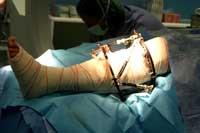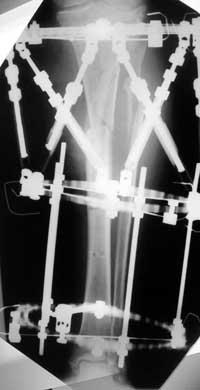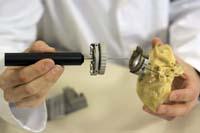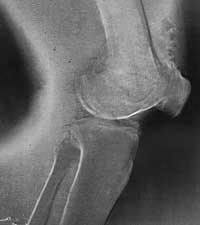More precise, digital bone control
2010/03/07 Lakar Iraizoz, Oihane - Elhuyar Zientzia

Completing a bone break according to the requirements of a computer system has at least one obvious advantage: "Computers don't fail," says José Ignacio Martínez, a doctor who first used this system at Policlínica Gipuzkoa.
Taylor is a three-dimensional external fixator with two rings and six bars between rings. To tie it to the bone, a plate is removed from the rings. Thus, hold the bone to complete throughout the round.
Suppose we have a badly formed bone, that is, that the pieces of bone do not weld aligned. In these cases it is necessary to break this bone and place it correctly so that it is permanently welded. As the Taylor fixer is perfect for these cases. This is stated by the specialists who have used it.

The Taylor external fastening keeps the bone to complete all round (Photo: Iñaki Martínez).
To fix the device, they "teach" you what is its neutral position, in which the six bars would be at the same distance, so all would be of the same length. Once this is determined, they deform the device and adapt it to the position of the ill-formed bone: each ring is placed on each side of the fracture and the bars between the two lengthen and shorten until they acquire that position.
Then the computer system is launched, which sees in what position the bars are located and what to do to return to the neutral position. Logically, the neutral position corresponds to the position that the parts of the bones should have. Therefore, once the neutral position is reached, the other will return to its natural position.
The computer system requires that patients do not have to go to the doctor periodically to adapt the fixator, the system tells them the bar to lengthen or shorten, when and how much.
Thirteen days available
Martínez gives his first intervention as an example of the operation of the system. About a year ago with a 43-year-old man. In a work accident the tibia broke and, as at that time they put the two bones wrong, at the time of the intervention had the inclined leg (and as a result of that dipping, that leg was shorter). Specifically, there were 20 degrees inclined from the position it should have.

Those who go with shoes only feel the impact of the shoe sole and not the cushions and joints of the feet (Photo: Morten Liebach).
"It was a complex operation," says Dr. Martinez. However, the next day the patient was able to put the leg on the ground. In fact, the device kept the upper and lower parts of the bone, so the body weight did not damage the bone.
Every day the patient followed the orders of the computer and “for thirteen days had the bone totally corrected,” said Martínez. Then he only had to wait for the gap between the bones to fill.
This filling is done by itself. Bones are able to form bone tissue and form bone where it is missing. Therefore, with devices that properly hold bones, such as Taylor, you can treat fractures and perform other interventions. For example, the bones of nested people may be prolonged. "We have known for a long time that bones can stretch as much as we want," said Martínez.
Published in 7K.

Gai honi buruzko eduki gehiago
Elhuyarrek garatutako teknologia






